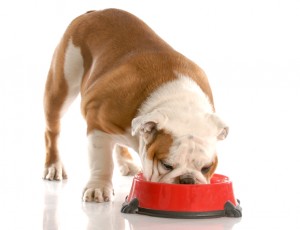
Some dogs have a tendency to guard their food, toys, bones or whatever they view as valuable. They may guard these “valuables” from other dogs, or they might guard them from people, too. Some dogs will just growl, while others will actually try to bite.
The following are some ideas on how to prevent and manage this type of aggressive behavior, often referred to as resource guarding. For the sake of this post, I’m focusing on one of the most common issues – guarding the food bowl.
As always, if you are even slightly concerned about being bitten by your dog, it’s a good idea to reach out to a professional trainer in your area for some help. Even one session with the right trainer can make all the difference.
Prevention and management
Feed the dog in a crate
In order to prevent resource guarding from developing or to manage existing resource guarding, a good rule of thumb to follow is to simply feed your dog in a crate or in a separate room, said Chris Amick, a professional trainer with Global K9 Services. This is especially true if you have multiple dogs.
“Food is a primary survival drive,” he said. “It is instinct.”
He said children should be taught to leave dogs alone when the dogs are eating, and adults should also give the dogs some space.
“My advice is, and always has been this: Leave the dog alone and let him enjoy his meal.”
What if the dog is already showing aggression around food?
If your dog is guarding her food, she is not being “dominant or disrespectful,” according to Jennifer Mauger, a professional trainer with L’Chaim Canine. “Guarding one's food is normal dog behavior.”
She said she does not believe in using punishment because it can “escalate your dog’s behavior or cause your dog to bite you.”
To eliminate food aggression, she suggests changing the dog’s emotional response to having people near the food bowl.
“Keeping a safe distance, walk by your dog and toss a really great treat, such as a small piece of cooked chicken, into or near the food bowl,” she said. “Do this several times during a meal.”
The goal with this approach is to gradually change the dog’s emotional response over time so when someone walks by her bowl, she will eventually think, “Yay! I get chicken!”
Amick said he typically helps a dog overcome food aggression by keeping a collar and leash on the dog while the dog is eating.
If the dog begins to curl his lips or growl, Amick said he immediately walks the dog away from the food and then calmly puts the dog in a sit position for about a minute. Once the dog is calm, he walks him back to the food, repeating this exercise as often as necessary.
Another idea he suggested is to feed the dog all of his food by hand. (And obviously you need to know your dog and use common sense.)
“While this sounds tiresome and tedious, it does work,” he said. “Measure out his kibble and let him eat it a palm full at a time.”
Have any of you had to deal with any resource guarding? How do you manage it?

